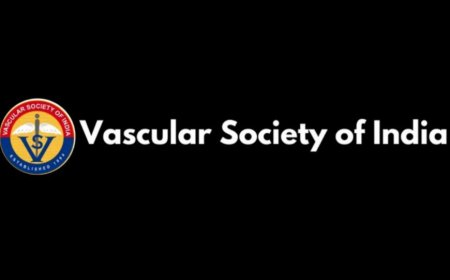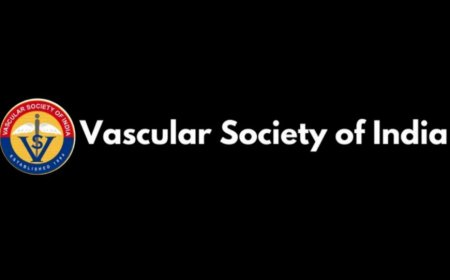A Focus on Aortic Artery Diseases: Don't Neglect the Symptoms
On the occasion of National Vascular Day, the Vascular Society of India (VSI) is proud to announce its annual Vascular Awareness Week from August 3-9. This year, we are placing a special emphasis on increasing awareness about vascular diseases and diseases of the aorta, the body's main artery is one of them. These conditions, which can be life-threatening if left undiagnosed and untreated, are often silent and therefore frequently neglected. What Is the Aorta and How Do Its Diseases Occur? The aorta is the largest artery in the body, originating from the heart and traveling through the chest and abdomen. It's responsible for distributing oxygenated blood to all parts of the body. Aortic diseases can arise when the wall of the aorta weakens, leading to a bulge or swelling, known as an aneurysm, or when a tear occurs in the inner layer of the artery, called a dissection. These conditions are often caused by the hardening of the arteries, known as atherosclerosis, which is a result of plaque buildup. Other contributing factors include high blood pressure (hypertension), smoking, and genetic disorders that affect connective tissue, such as Marfan syndrome. Incidents in India and Risk Factors While comprehensive nationwide data on aortic diseases in India is limited, existing studies and clinical observations suggest a significant and growing burden. The prevalence of cardiovascular risk factors like diabetes and hypertension is rapidly increasing in India, which in turn elevates the risk of aortic diseases. A notable risk factor is smoking, which makes people three to five times more likely to develop an aortic aneurysm. Given the country's demographic shift towards an aging population and the high prevalence of these risk factors, it's crucial to raise awareness and promote early screening and detection. While older men are the highest-risk demographic for abdominal aortic aneurysms (AAAs), it's important to recognize that these conditions can affect anyone with the aforementioned risk factors. Signs, Symptoms, and When to Seek Help A major challenge with aortic diseases is that they are often asymptomatic in their early stages. An aneurysm can grow silently over years without causing any noticeable symptoms. This is why it's often called a "silent killer." However, as the aneurysm enlarges or when a dissection occurs, symptoms can manifest. Common signs and symptoms include: Sudden, severe pain in the chest, back, or abdomen, which may be described as a tearing or ripping sensation. This is a medical emergency. A pulsating sensation in the abdomen, similar to a heartbeat. Hoarseness or difficulty swallowing, if the aneurysm is located in the chest and presses on the windpipe or esophagus. Shortness of breath or dizziness. It's vital to recognize that these symptoms can mimic other conditions. However, the sudden onset of severe chest or back pain should never be ignored. If these symptoms persist, seeking immediate medical attention is essential. Treatment and Prevention The treatment for aortic diseases depends on the type, size, and location of the condition, as well as the patient's overall health. Treatment options include: Medical Management: For small aneurysms, doctors may recommend a "watchful waiting" approach, which involves regular monitoring with imaging tests like ultrasound or CT scans. Medications to control blood pressure and cholesterol may also be prescribed. Surgical Repair: For larger aneurysms or dissections, surgical intervention is necessary to prevent rupture. This can be done through a traditional open surgery, where a surgeon replaces the damaged part of the aorta with a synthetic tube or graft. Endovascular Aneurysm Repair (EVAR): This is a less invasive procedure where a stent graft is inserted through small incisions, typically in the groin, and guided into the aorta to reinforce the weakened wall. Prevention is key to avoiding aortic diseases. The best way to reduce your risk is by adopting a heart-healthy lifestyle: Quit smoking. This is the single most effective action you can take. Manage your blood pressure and cholesterol. Work with your doctor to keep these under control through diet, exercise, and medication if needed. Maintain a healthy weight. Exercise regularly. Even moderate physical activity can significantly improve vascular health. Control diabetes. Know your family history. If you have a family history of aortic aneurysms, you may be at higher risk and should discuss screening with your doctor. A Message from the Vascular Society of India On this National Vascular Day and throughout Vascular Awareness Week, the VSI urges everyone to take their vascular health seriously. Aortic diseases are serious but treatable, especially when detected early. Don't let these conditions go unnoticed. We cannot stress this enough: do not neglect the symptoms if they persist. Your prompt atte

On the occasion of National Vascular Day, the Vascular Society of India (VSI) is proud to announce its annual Vascular Awareness Week from August 3-9. This year, we are placing a special emphasis on increasing awareness about vascular diseases and diseases of the aorta, the body's main artery is one of them. These conditions, which can be life-threatening if left undiagnosed and untreated, are often silent and therefore frequently neglected.
What Is the Aorta and How Do Its Diseases Occur?
The aorta is the largest artery in the body, originating from the heart and traveling through the chest and abdomen. It's responsible for distributing oxygenated blood to all parts of the body. Aortic diseases can arise when the wall of the aorta weakens, leading to a bulge or swelling, known as an aneurysm, or when a tear occurs in the inner layer of the artery, called a dissection.
These conditions are often caused by the hardening of the arteries, known as atherosclerosis, which is a result of plaque buildup. Other contributing factors include high blood pressure (hypertension), smoking, and genetic disorders that affect connective tissue, such as Marfan syndrome.
Incidents in India and Risk Factors
While comprehensive nationwide data on aortic diseases in India is limited, existing studies and clinical observations suggest a significant and growing burden. The prevalence of cardiovascular risk factors like diabetes and hypertension is rapidly increasing in India, which in turn elevates the risk of aortic diseases. A notable risk factor is smoking, which makes people three to five times more likely to develop an aortic aneurysm.
Given the country's demographic shift towards an aging population and the high prevalence of these risk factors, it's crucial to raise awareness and promote early screening and detection. While older men are the highest-risk demographic for abdominal aortic aneurysms (AAAs), it's important to recognize that these conditions can affect anyone with the aforementioned risk factors.
Signs, Symptoms, and When to Seek Help
A major challenge with aortic diseases is that they are often asymptomatic in their early stages. An aneurysm can grow silently over years without causing any noticeable symptoms. This is why it's often called a "silent killer." However, as the aneurysm enlarges or when a dissection occurs, symptoms can manifest.
Common signs and symptoms include:
-
Sudden, severe pain in the chest, back, or abdomen, which may be described as a tearing or ripping sensation. This is a medical emergency.
-
A pulsating sensation in the abdomen, similar to a heartbeat.
-
Hoarseness or difficulty swallowing, if the aneurysm is located in the chest and presses on the windpipe or esophagus.
-
Shortness of breath or dizziness.
It's vital to recognize that these symptoms can mimic other conditions. However, the sudden onset of severe chest or back pain should never be ignored. If these symptoms persist, seeking immediate medical attention is essential.
Treatment and Prevention
The treatment for aortic diseases depends on the type, size, and location of the condition, as well as the patient's overall health.
Treatment options include:
-
Medical Management: For small aneurysms, doctors may recommend a "watchful waiting" approach, which involves regular monitoring with imaging tests like ultrasound or CT scans. Medications to control blood pressure and cholesterol may also be prescribed.
-
Surgical Repair: For larger aneurysms or dissections, surgical intervention is necessary to prevent rupture. This can be done through a traditional open surgery, where a surgeon replaces the damaged part of the aorta with a synthetic tube or graft.
-
Endovascular Aneurysm Repair (EVAR): This is a less invasive procedure where a stent graft is inserted through small incisions, typically in the groin, and guided into the aorta to reinforce the weakened wall.
Prevention is key to avoiding aortic diseases. The best way to reduce your risk is by adopting a heart-healthy lifestyle:
-
Quit smoking. This is the single most effective action you can take.
-
Manage your blood pressure and cholesterol. Work with your doctor to keep these under control through diet, exercise, and medication if needed.
-
Maintain a healthy weight.
-
Exercise regularly. Even moderate physical activity can significantly improve vascular health.
-
Control diabetes.
-
Know your family history. If you have a family history of aortic aneurysms, you may be at higher risk and should discuss screening with your doctor.
A Message from the Vascular Society of India
On this National Vascular Day and throughout Vascular Awareness Week, the VSI urges everyone to take their vascular health seriously. Aortic diseases are serious but treatable, especially when detected early. Don't let these conditions go unnoticed. We cannot stress this enough: do not neglect the symptoms if they persist. Your prompt attention to your body's signals can make a life-saving difference. Consult with a vascular specialist if you have any concerns. Together, we can work towards an "Amputation-Free India" and a healthier, more aware nation.
What's Your Reaction?
























































